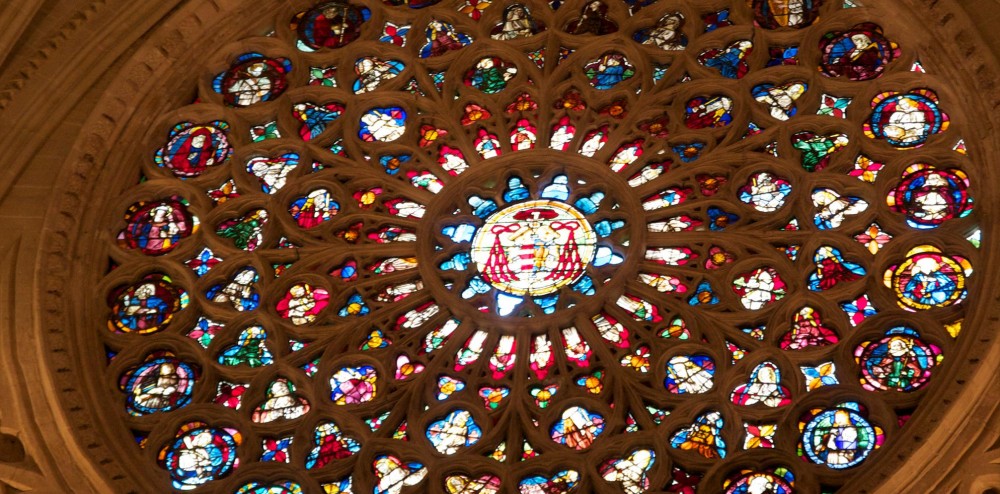The Gospel for the Passion (Palm) Sunday for Year A of the three year cycle of Sunday readings is from Matthew. The dramatic proclamation of the Passion Narrative evokes the profound realization in the congregation: our faith emphasizes that Jesus died for our sins and rose for us to be brought into right order with God the Father (see Romans 4:25; Corinthians 15:3-5).
In the Good Friday service, each Christian is invited to adore Jesus as the crucified Lord, again recalling that he died for our sins. The traditional chant during this ceremony was the “Reproaches,” often misinterpreted by the commentators to be an indictment of the Jews. Indeed, the choir sings the verses in biblical terms but the choir’s response to each verse concludes, “Have mercy on us.” See my and J.F. Henderson’s essay in The Liturgy of the Medieval Church (Kalamazoo: Medieval Institute Publications, 2005) p. 187-214. The comment of Bishop William Durand (1230-1296) on the Palm Sunday liturgy shows the true Christian approach to the liturgical commemoration of the sufferings of Jesus:
We must rejoice concerning the fruit of his Passion, and suffer with him, because he suffered for us. We rejoice, therefore, of the love which he showed for us on the cross, and we are sad because of our sins, which are so many, on account of which the Son of God had to suffer. (Rationale Divinorum Officiorum VI.37.11)
Extending the liturgical experience of divine forgiveness, various practices and devotions developed over the centuries to reinforce our sense of gratitude for the Paschal Mystery of Jesus’ death-and-resurrection. However, even here the anti-Jewish prejudices might be asserted. When in Copenhagen overnight in 2006, I was surprised to hear Angelus bells early in the next morning. I found the Sacred Heart church nearby and paid a visit. The Stations of the Cross were painted very nicely with a feature that I hope was never found elsewhere. In the corner of the first station, Jesus being condemned by Pontius Pilate, was a figure with a scroll. The words in Latin were visible: “Sanguis eius super nos et super filios nostros – His blood be upon us and upon our children” (Matthew 27:25). A small version of the same person holding the scroll was incorporated into each of the next 13 stations. What a distortion of the pious purpose of this substitute for a pilgrimage to Jerusalem!
I wish to draw attention to the recent commentary on Matthew’s Gospel by Father Brendan Byrne, S.J. This quotation is taken from the Paulist Biblical Commentary (Paulist Press, 2018) p. 967:
No single verse in Matthew’s Gospel needs more careful consideration than the cry of “the whole people” in verse 25. There is no need to labor the injury it has caused to Jewish people since the earliest times. Where Matthew has previously referred to the “crowd(s)” (ochlos [oi] [27:15, 20, 24]), at this point he writes “the whole people” (pas ho laos), a term principally used in the Gospel (albeit mostly in scriptural quotations) of the nation (of Israel) as a whole (1:21; 2:6; 4:16, 23; 13:15; 15:18), though often in the stock phrases “scribes/elders of the people” (2:4; 21:23; 26:3, 47; 27:1). It is by no means clear, however, that “people” (laos) in verse 25 refers to the nation as a whole, let alone Jewish people for all time. Since Jesus’ entry into Jerusalem there has been a distinction between the crowds who accompanied him and the people of Jerusalem itself (see 21:8-11), Jerusalem that he has already characterized as “the city that kills the prophets and stones those who are sent to it” (23:37). It is likely, then, that “people” here refers specifically to the populace of Jerusalem.
Likewise, the final phrase, “and on our children,” is to be interpreted strictly. Along with Luke (23:27-31) and the author of the Fourth Gospel (11:47-48), Matthew sees the Roman conquest of Jerusalem and burning of the temple in 70 CE as divine punishment for the city’s rejection of Jesus as Messiah. The generation that would be alive to suffer these events would be precisely the “children” of those who had accepted responsibility for Jesus’ blood some forty years before. It is to this generation, then- and to no other beyond it- that the phrase “and on our children” refers. The text provides no justification for a “blood guilt” passed on down subsequent generations within the whole of Judaism.
I thank him for this succinct and pertinent interpretation of the passage that has been the basis of accusations against the Jewish people of later times. Rather, we should recall the words of the Second Vatican Council: “The Church always held and continues to hold that Christ out of infinite love freely underwent suffering and death because of the sins of all people, so that all might attain salvation” (Declaration of the Church’s Relations to Non-Christian Religions, Nostra aetate 4).


The crowds at Jesus’ trial may have cried out ‘ his blood be upon us. and upon our children ‘ That was not what God said. In fact God says in Ezekiel 18 that the sons shall not suffer for the sins of the father but everyone is responsible for his own sins.